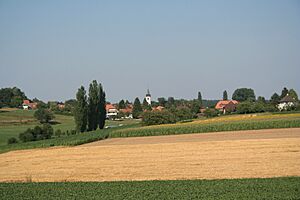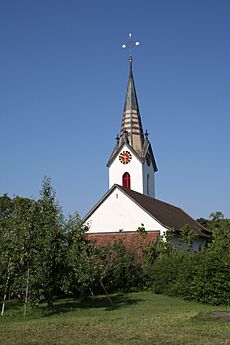Wengi facts for kids
Quick facts for kids
Wengi
|
||
|---|---|---|

Wengi village administration building
|
||
|
||
| Country | Switzerland | |
| Canton | Bern | |
| District | Seeland | |
| Area | ||
| • Total | 7.08 km2 (2.73 sq mi) | |
| Elevation | 480 m (1,570 ft) | |
| Population
(Dec 2020 )
|
||
| • Total | 630 | |
| • Density | 89.0/km2 (230.5/sq mi) | |
| Postal code |
3251
|
|
| Surrounded by | Balm bei Messen (SO), Diessbach bei Büren, Grossaffoltern, Rapperswil, Ruppoldsried, Schnottwil (SO) | |
Wengi is a small town, also called a municipality, in Switzerland. It is located in the Seeland area of the canton of Bern.
Contents
Wengi's Past: A Look at Its History
Wengi was first written about around the years 1261-1263. Back then, it was called Wengw. Later, in 1303, its name changed to Wengi.
Early Settlements and Ancient Times
The very first signs of people living here come from the Neolithic Age. This was a time when people used stone tools. These tools were found in a place called Wengimoos.
Some items from the Roman times were also found in an area called Äbeni.
Castles and Medieval Life
During the Middle Ages, a wooden castle stood guard over the village. It was called Guldige Hubel. Wengi, along with two small villages named Scheunenberg and Waltwil, were part of a larger municipality called Grossaffoltern. They were owned by a powerful family known as the House of Kyburg. After this family no longer existed, different noble families owned the villages.
The Village Church
The St. Mary's Church in Wengi was likely built a very long time ago. It might have been built in the 8th or 9th century. A new church was built in the 13th century. It became the main church for a dean, who is a church leader.
In 1521, a fire destroyed this second church. It was rebuilt with a long main hall, called a nave. The church was then given to St. Maurice.
Peat Harvesting and Nature Protection
From the 1700s until World War II, people dug up peat from the Wengimoos bog. Peat is like a type of soil that can be burned for heat. These large peat bogs made it hard to improve the Limpach valley. This work happened between 1944 and 1951.
In 1961, the Wengimoos area became a nature preserve. This was done to protect its special bog environment.
Wengi's Location and Land
Wengi covers an area of about 7.10 square kilometers (2.74 square miles).
How the Land is Used
- Most of the land, about 72.8%, is used for agriculture. This means it's used for farming.
- About 16.7% of the land is covered by forests.
- Around 7.6% of the land has buildings or roads on it.
- A small part, 1.3%, is made up of rivers or lakes.
- The remaining 1.4% is land that cannot be used for farming or building.
Parts of Wengi
The municipality of Wengi is in the upper Limpach valley. It includes the main village of Wengi. It also has smaller areas called Scheunenberg, Waltwil, and Janzenhaus.
Changes in Administration
On December 31, 2009, the old district of Amtsbezirk Büren was closed. The next day, Wengi became part of the new Verwaltungskreis Seeland district.
Wengi's Coat of Arms
The coat of arms for Wengi is described as: Argent three Roses Gules barbed and seeded proper in Pale. This means it has a silver background. On it, there are three red roses, one above the other. They have their green parts and seeds showing.
People of Wengi: Demographics
Wengi has a population of about 615 people. In 2010, about 8.1% of the people living in Wengi were from other countries. Over ten years (from 2000 to 2010), the number of people living in Wengi grew by 12.2%.
Languages Spoken
Most people in Wengi speak German. About 96% of the population speaks German as their first language. French is the second most common language, spoken by 1.8%. Portuguese is third, spoken by 0.7%.
Where People Come From
In 2000, about 37.5% of the people in Wengi were born there. About 39.3% were born in the same canton (Bern). Around 14.9% were born in other parts of Switzerland. About 6.5% were born outside of Switzerland.
Age Groups
In 2010, children and teenagers (ages 0–19) made up 23.4% of the population. Adults (ages 20–64) made up 61.6%. Seniors (over 64 years old) made up 15%.
Family Life
In 2000, there were 224 single people in Wengi who had never been married. There were 277 married people. Also, there were 32 widows or widowers and 19 divorced people.
Housing in Wengi
In 2000, there were 51 homes where only one person lived. There were 17 homes with five or more people. Most apartments (95.4%) were lived in all the time. A few (2.3%) were used only at certain times of the year. Another 2.3% were empty.
In 2010, new homes were being built at a rate of 1.6 new homes for every 1000 people. In 2011, about 2.94% of homes were empty.
Population Changes Over Time
The chart below shows how Wengi's population has changed through the years:

Wengi's Economy: How People Work
In 2011, Wengi had a low unemployment rate of 1.59%. This means most people who wanted to work had jobs.
Jobs in Wengi
In 2008, 161 people worked in Wengi.
- 88 people worked in the primary sector. This includes jobs like farming. There were 29 businesses in this area.
- 19 people worked in the secondary sector. This includes jobs like manufacturing and building. There were 6 businesses in this area.
- 54 people worked in the tertiary sector. This includes jobs in services, like shops or restaurants. There were 17 businesses in this area.
Types of Full-Time Jobs
In 2008, there were 121 full-time equivalent jobs.
- 60 jobs were in farming.
- 16 jobs were in the secondary sector. Most of these (14) were in manufacturing. Two were in construction.
- 45 jobs were in the tertiary sector. These included jobs in sales, transport, hotels, and education.
Commuting to Work
In 2000, 28 workers came into Wengi for their jobs. However, 195 workers left Wengi to work in other places. This means many more people leave Wengi for work than come in.
About 6.7% of working people used public transportation to get to work. A large number, 57%, used a private car.
Religion in Wengi
Based on the 2000 census:
- About 7.1% of people were Roman Catholic.
- About 79.9% belonged to the Swiss Reformed Church.
- A small number (0.54%) were Orthodox Christians.
- About 3.26% belonged to other Christian churches.
- One person was Islamic.
- About 8.15% of the people did not belong to any church. They might be agnostic (not sure about God) or atheist (do not believe in God).
- About 2.54% of people did not answer the question about their religion.
Education in Wengi
In Wengi, about 38.6% of people have finished upper secondary education. This is schooling after middle school that is not required. About 15% have gone on to higher education. This means they attended a university or a special college called a Fachhochschule.
School System in Bern
The school system in the Canton of Bern works like this:
- One year of optional Kindergarten.
- Six years of Primary school.
- Three years of required lower Secondary school. In this stage, students are grouped by their skills.
- After lower secondary school, students can continue their education or start an apprenticeship. An apprenticeship is like learning a job while working.
Students in Wengi Schools
During the 2009-2010 school year, 73 students attended classes in Wengi.
- There was one kindergarten class with 14 students. Some of these students (14.3%) were not Swiss citizens. Also, 14.3% spoke a different language at home than the one used in class.
- There were three primary classes with 59 students. About 6.8% of these students were not Swiss citizens. Also, 3.4% spoke a different language at home than the one used in class.
In 2000, 13 students came to Wengi for school from other towns. At the same time, 36 students from Wengi went to schools outside the municipality.
See also
 In Spanish: Wengi bei Büren para niños
In Spanish: Wengi bei Büren para niños






